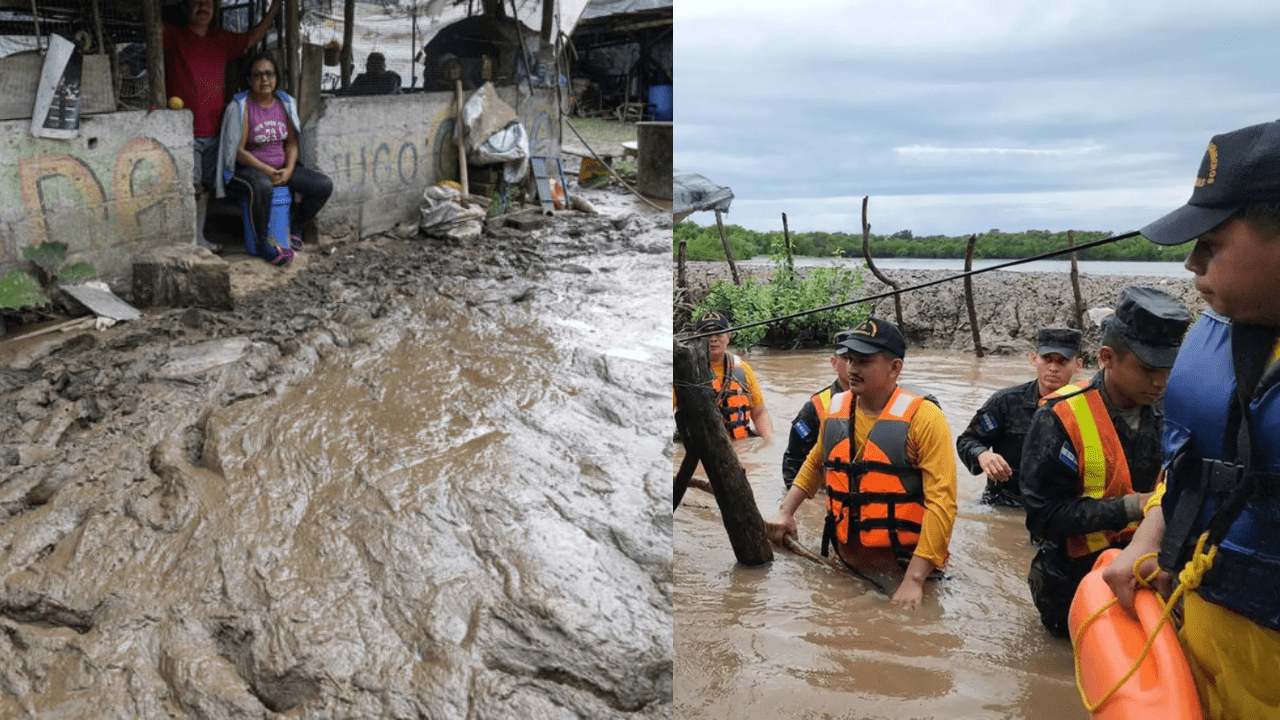Central America Faces Devastating Storms and Torrential Rains: Over 30 Dead and Thousands Displaced!

Central America is currently enduring a severe weather crisis, with unrelenting storms and heavy rainfall resulting in over 30 fatalities and forcing thousands to evacuate their homes. The continuous downpours have led to widespread flooding, landslides, and significant destruction of property, leaving entire communities isolated and in distress.
El Salvador: A Nation in Mourning
In El Salvador, the death toll has tragically climbed to 19, including six children. Over 3,000 individuals have sought refuge in temporary shelters as the nation grapples with the extensive damage caused by the storms. Luis Amaya, head of El Salvador’s civil protection agency, emphasized the urgency of the situation. “We must save people’s lives,” he stressed during a press briefing on Friday. “Material goods can be replaced, but our immediate focus must be on protecting lives.”
Guatemala: Extensive Evacuations and Damage
Guatemala is also facing severe repercussions from the relentless weather. Officials reported 10 deaths and the evacuation of nearly 11,000 people, with approximately 380 individuals remaining in temporary shelters. The destruction is extensive, with 300 structures severely damaged and four bridges destroyed, further complicating relief efforts and isolating communities in desperate need of assistance.
Honduras: Communities Cut Off
Neighboring Honduras has reported one death and the evacuation of over 1,200 people, including 300 in the last 24 hours alone. The rains have wreaked havoc on the country’s infrastructure, cutting off 180 communities and destroying 22 houses. The government is working tirelessly to reach those affected and provide necessary aid, but the challenges are immense.
Mexico: Mixed Blessings of Torrential Rains
In Mexico, the weather forecast predicts continued heavy rains across most regions of the country. Authorities are bracing for torrential downpours along the Pacific and Atlantic coasts, as well as further inland, which are expected to bring lightning, strong winds, hail, and potential flooding around rivers.
The rains have prompted the evacuation of about 80 people from a children’s hospital in Oaxaca state on Thursday. However, there is a silver lining; the rainfall has brought much-needed replenishment to drought-stricken reservoirs, which are currently at about a third of their capacity.
Mexico’s National Water Commission (Conagua) has issued warnings of wind speeds reaching up to 70 kilometers per hour (44 mph) and waves as high as 3 meters (10 feet) along the Gulf and Caribbean coasts. The Pacific coast is also under alert for similarly strong winds, which could potentially lead to tornadoes.
The Meteorological Perspective on Torrential Rains
The severe weather is attributed to a combination of low-pressure channels interacting across much of the region, along with a monsoon trough drawing moist ocean air from the North Pacific. These conditions have been exacerbated by the remnants of Alberto, the first named tropical storm of the Atlantic hurricane season. Alberto alone caused at least four deaths as it swept over northeastern Mexico earlier in the week.
According to the U.S. National Hurricane Center, the heavy rainfall is expected to persist through Friday, impacting southern Mexico and northern Central America. The forecast includes thunderstorms and showers extending as far south as Costa Rica and Panama into the weekend.
Humanitarian Response and Future Outlook
The ongoing crisis in Central America highlights the urgent need for international support and effective disaster management strategies. Governments and humanitarian organizations are working around the clock to provide aid, but the scale of the disaster requires a coordinated and robust response.
The human toll and material damage underscore the region’s vulnerability to extreme weather events, which are becoming increasingly frequent and intense due to climate change. Long-term solutions must include investment in resilient infrastructure, early warning systems, and community preparedness programs to mitigate the impact of future storms.
In the immediate term, the priority remains the protection of human lives and the provision of essential services to those affected. Relief efforts are focused on delivering food, water, medical care, and shelter to displaced populations. Additionally, efforts to restore communication and transportation links are crucial for effective coordination and delivery of aid.
As Central America and neighboring regions continue to battle these severe weather conditions, the resilience and solidarity of the affected communities, combined with timely and effective intervention, will be key to overcoming this crisis. The international community must stand ready to support these efforts, recognizing that in the face of natural disasters, collective action and compassion can make a significant difference.
Also Read:

The Psychology of Love: Why Valentines Day Matters More Epic Than You Think
Discover the psychology of love and why Valentines Day is more important than you think. Learn how love impacts the brain, strengthens relationships, and boosts

Premier League Highlights: Arsenal Humiliate Man City 5-1, Spurs and Palace Secure Crucial Wins
Arsenal demolished Manchester City 5-1 in a statement premier league highlights win, reigniting their title hopes. Meanwhile, Crystal Palace stunned Man United 2-0, and Tottenham

How Budget 2025 Impacts the Indian Middle-Class: Major Tax Benefits and Glaring Omissions
Budget 2025 offers major tax relief to the middle class, including zero tax on incomes up to ₹12 lakh. However, it misses out on incentives

Degrees vs Employability: Why “Highly Qualified Degree Holders” Struggle to Find Jobs While “Less Qualified Individuals” Get Hired Faster!
Many highly qualified individuals struggle to secure jobs, while less qualified candidates get hired quickly. This Degrees vs Employability paradox is caused by employer preferences,

The Power of Mindset: Why Looking Poor Doesn’t Make You Poor, but Thinking Poor Does!
Discover why looking poor doesn’t define your wealth but thinking poor does. Learn the power of mindset and how a growth-oriented mindset can lead to

Overthinking: How It’s Damaging Today’s Youth – Causes and Cure in 2025
Understanding how overthinking is silently damaging today’s youth, from its causes rooted in societal pressure and social media to its long-term effects on mental health.
